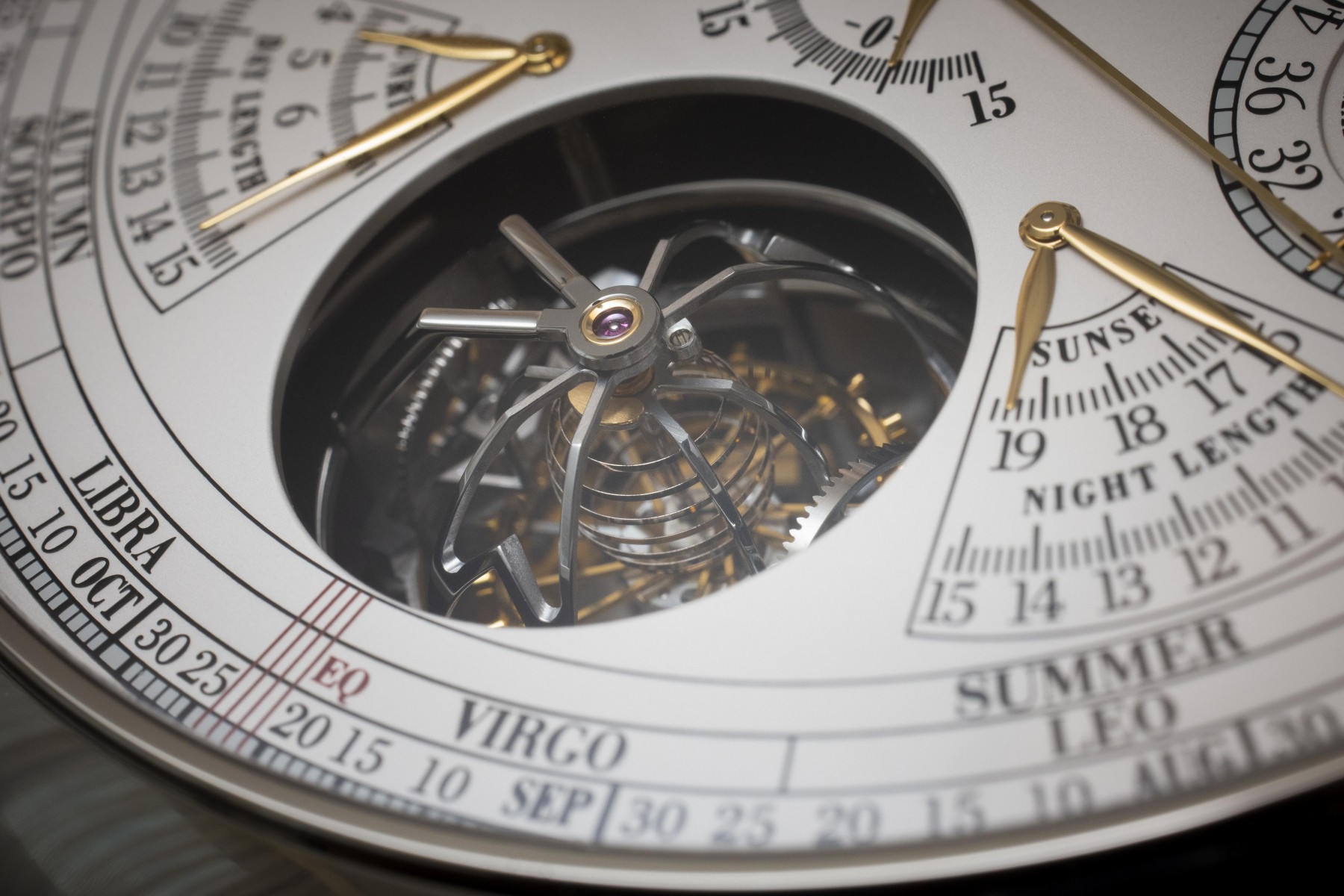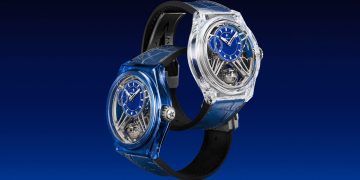Source: Images and content by Vacheron Constantin
http://content.presspage.com/uploads/1999/500_vac-hwm-tourbillon-reference-57260-t.jpg?10000
- The start of the 19th century witnessed the emergence of the tourbillon, a complex and fascinating mechanism designed to counter the effects of gravity on watch mechanisms.
- This horological complication representing an integral part of Vacheron Constantin’s history since 1901 has played a major role in the quest for precision within the Manufacture
- In its most accomplished version, the tourbillon is a watchmaking masterpiece that is indispensable in Grand Complications watches and a Vacheron Constantin speciality found in current collections as well as the heart of many one-of-a-kind Les Cabinotiers models.
Geneva, September 1st – Invented by Abraham-Louis Breguet at the beginning of the 19th century, the tourbillon’s primary function is to counteract the effects of gravity on watch mechanisms. This device is a symbol of technical mastery and craftsmanship. The first known traces of its commercialization found in Vacheron Constantin’s archives date back to 1901. Since then, this complication has become part of the Maison’s watchmaking heritage, integrated into pocket watches, then wristwatches from the early 1990s, as well as into exceptional pieces intended for connoisseurs and collectors.
The history of tourbillons
The tourbillon is often considered a masterpiece of the watchmaking art. And while it is not strictly speaking considered a horological complication, since it does not offer an additional function alongside the time indications, it is nonetheless a mechanical system as complex as it is fascinating. Developed in 1795 and patented in 1801 by Abraham-Louis Breguet, it was designed to eliminate the errors in rate caused by the Earth’s gravity.
Few watchmakers tried their hand at the tourbillon during the 19th century and the quantities produced remained extremely modest. As a regulating organ, however, this mechanism proved itself sufficiently well for it to be taken into consideration not only for so-called chronometry watches, in search of absolute precision, but also as the component of choice for Grand Complication models. Vacheron Constantin has distinguished itself in both these fields with its perfect mastery of this complex watchmaking mechanism.
The invention of the tourbillon is intimately bound up with sartorial habits as well as the horological knowledge and practices of the late 18th century. The pocket watches of that era suffered from several mechanical defects, due in particular to the artisanal component production. They were tricky to poise and tended to endure excessive friction, only partially mitigated by the lubricants then available which tended to congeal. In addition, wearing the watch in a waistcoat pocket meant it mostly remained in a static and vertical position. The watch calibre, and particularly its regulating organ forming the link with the escapement, was thus adversely affected by the Earth’s gravity, which perturbed the isochronism of the balance-spring, synonymous with deviations in rate and therefore a loss of precision.
The solution therefore called for a new mobile system. In a traditional mechanical movement, the escapement and the balance-and-spring assembly are affixed to the mainplate in such a way that they mesh by pivoting on their axis. With the tourbillon, these same components are combined in a rotating carriage, suspended between its two pivot points. This carriage functions as a fourth wheel and pinion, driven by the third wheel, causing the balance-spring to successively adopt all the vertical positions, even though the watch remains stationary within the waistcoat pocket. The combination of positions therefore serves to compensate for variations in order to achieve an average rate, a factor conducive to enhanced precision.
For a century and a half, the tourbillon changed very little, immutably based on the same principle of a rotating carriage. The only significant variation was the karussel, a mechanism patented by the Danish watchmaker Bahne Bonniksen in 1892. This mechanism also aims to improve the precision of the watch by embedding the escapement and the regulator within a rotating module. It differs from the tourbillon in that it is driven by two distinct forces: one for cage and the other for the escapement. With the advent of wristwatches, which are by definition in constant motion, the usefulness of the tourbillon became a recurring issue within the watchmaking community, as did that of “plat-pendu” in the world of pocket watches, i.e. the difference in rate observed in the same timepiece in respective horizontal and vertical positions where the amplitude is smaller. While no definitive answer has been found, recent research and innovative features added to the tourbillon can be considered the best existing solution.
Vacheron Constantin and tourbillons
The first mention of a tourbillon pocket watch in the Vacheron Constantin archives dates back to 1901. A letter addressed to the Maison relates to an order placed by a Parisian client for a timepiece with a tourbillon escapement, double chronograph, Grande and Petite Sonnerie, minute repeater, perpetual calendar with moon phases and power reserve. In other words, an exceptional timepiece that must also be submitted to the Geneva Observatory in order to obtain its chronometry (precision timekeeping certificate). Since its founding in 1755, Vacheron Constantin had already had the opportunity to demonstrate its expertise in the field of watch complications.
At the turn of the 20th century, this technical mastery took on a new dimension with the creation of ultra-complicated watches, some of which included a tourbillon, such as a 1917 pocket watch acquired by the Maharajah of Patiala, a great collector of timepieces. Until the 1950s, the Maison distinguished itself by creating highly technical pocket watches that have become part of watchmaking history. The now famous Reference 57260 , a pocket watch presented in 2015 to mark the 260th anniversary of Vacheron Constantin, is also a tribute to these creations. Its 57 complications notably include a very rare triple-axis tourbillon with a spherical balance spring that regulates the effects of gravity so that the time is in no way affected by random changes in the position of the wearer. In 2019, Vacheron Constantin once again demonstrated its technical mastery by welcoming the tourbillon to the Overseas collection. Calibre 2160, an ultra-thin selfwinding movement, appeared one year later at the heart of the Overseas tourbillon in an all 18K gold 5N version with a blue lacquered dial.
A tradition of precision
This quest for precision is a constant at Vacheron Constantin, whose desire has always been to produce robust, reliable and accurate watches radiating pure elegance. From 1872 onwards, the Manufacture regularly entered the various precision competitions organised by the Geneva and Neuchâtel Observatories, as well as those in England and the United States, and its watches regularly won gold medals or first prizes. Thanks to the reliability of Vacheron Constantin’s calibres, the Maison’s adjusters worked wonders during these watchmaking contests – to the point where one of them, Edmond Oliver, went down in history as the talent behind these chronometric feats. Several pocket models that he entered in the Geneva Observatory competition excelled in terms of precision. He notably trained the adjuster Hélène Jaccard, herself the holder of numerous records.
Vacheron Constantin made this chronometric performance one of its primary qualities and the Chronomètre Royal significantly contributed to this reputation. This pocket watch presented in 1907 perpetuated this tradition of precision, ensuring its international success throughout the century. Yet this quest for precision also involved more advanced research into movement architecture and tourbillon regulation systems. As early as the 1900s, Vacheron Constantin offered pocket watches incorporating a tourbillon as the only “complication” – regarded as an additional guarantee of accuracy in time measurement. These watches were logically also subjected to Observatory tests, including this 1907 model of which the movement blank was developed by Albert Pellaton, a brilliant watchmaker hired in the Manufacture’s R&D department as soon as he left school. There was no lack of success, as over the next four decades, Vacheron Constantin’s tourbillon pocket chronometers won a series of distinctions in various chronometry competitions, including three first-class certificates and six referenced first prizes.
A starring role in wristwatches
The appearance of tourbillons in Vacheron Constantin wristwatches reflects this same concern for precision. It also came at a time when the Maison was clearly demonstrating its desire to restore the mechanical watch to its former glory, despite the threat posed by the quartz crisis. At the end of the 1980s, Vacheron Constantin launched two projects to develop new calibres for wristwatches incorporating the legendary complications of the tourbillon and minute repeater. A first piece was produced in 1992, with the 30050 model. The tone was set: from then on, Vacheron Constantin would serve the cause of complicated watches with models in which the tourbillon played an essential role.
This regulating mechanism was thus gradually incorporated into the Maison’s various collections, either in a refined chronometric version or accompanied by other horological functions, and in some instances as part of Grand Complication models. This evolution was further reinforced by the establishment in 1998 of the Manufacture in the Vallée de Joux, with workshops dedicated to complex watch movements. Their first project was the development of a tourbillon calibre for the barrel-shaped movement of the Malte collection.
Over the years, this technical mastery of rotating regulators has found several remarkable applications, including the tourbillon presented on the occasion of the company’s 250th anniversary with the Saint-Gervais perpetual calendar timepiece boasting an exceptional 250-hour power reserve thanks to its four barrels (Calibre 2250); the dual-axis tourbillon with cylindrical balance spring (Calibre 1990); and the first self-winding in-house tourbillon with peripheral rotor (Calibre 2160). At the heart of all these achievements lies a fascinating mechanism raising horological science to an art form.
Henry Graves Jr. and Vacheron Constantin
The fact that American banker Henry Graves Jr. (1868-1953) became a household name in the watchmaking world is mainly due to the “duel” between him and industrialist James Ward Packard during the 1920s and 1930s, as the two passionate fine watchmaking collectors vied with each other to determine which of them would own the world’s most complicated watch. Henry Graves was an avid collector of multi-functional timepieces, but also nurtured a passion for precision chronometers, which is how he crossed paths with Vacheron Constantin in 1928.
That year, he learned that a Vacheron Constantin tourbillon watch had won a precision record at the Geneva Observatory. For the banker, this model had to be part of his collection. The correspondence between Henry Graves and Vacheron Constantin dates from this period. It shows his desire to acquire this watch, engraved with the following inscription: “Awarded First Prize (866 Points) Geneva Astronomical Observatory Timing Contest 1927-28 – No. 401562 – Henry Graves Jr. – New York – by Vacheron & Constantin, Geneva, Switzerland”. The relationship between Henry Graves and Vacheron Constantin did not end there, continuing in step with the proposals the Maison House submitted to the great collector – as evidenced by letters preserved in the Vacheron Constantin archives.
———————————————————————————————
Watch selection
Yellow gold one-minute tourbillon pocket watch – 1943 (Ref. Inv. 10811)
The quest for chronometric precision resulted in pocket watch models equipped with a tourbillon. These models often took part in chronometry competitions organised by various astronomical observatories, winning numerous distinctions. This yellow gold model with a one-minute tourbillon, bearing a small seconds hand on its shaft and featuring a white enamel dial and railway-type minute track, won First Prize at the Geneva Observatory in 1931, 1933 and 1941.
Yellow gold one-minute tourbillon pocket watch – 1945 (Ref. Inv. 11968)
With its 22’’’ movement, this yellow gold one-minute tourbillon pocket watch with small seconds is strikingly elegant. The silver-toned dial, punctuated by enamelled Roman numerals and a railway-type minute track, is swept over by slender open-tipped hands. The same concern for discreet elegance can be found on the back of the watch revealing a movement partially covered with a 2/3 plate adorned with the Côtes de Genève motif. This structure highlights the tourbillon whose balance with inertia blocks enables extremely fine chronometric adjustment. This observatory watch was designed as a precision chronometer.
White gold “Les Complications” tourbillon pocket watch – 1990 (Ref. Inv. 11927)
This pocket watch, produced in a limited edition, was commissioned by Asprey London, which has its headquarters in New Bond Street. To satisfy collectors nostalgic for precision chronometers in the early 1990s, Vacheron Constantin created this white gold model with a guilloché dial featuring a “basketweave” motif. Its 22’’’ movement was chosen accordingly. A tried and tested calibre with a one-minute tourbillon designed in the early 1940s, it took part in 19 chronometry competitions until the 1990s. The 6 o’clock dial aperture allows the full subtlety of the regulator to be admired.
Platinum tourbillon wristwatch with power-reserve display, model 30050 – 1993 (ref. Inv. 11984)
This timepiece is part of the first series of tourbillon wristwatches made by Vacheron Constantin. Produced in a limited edition of 300 in yellow gold and platinum, it is equipped with a calibre featuring two barrels, visible through the sapphire caseback. At 6 o’clock, the matt grained dial with three Roman numerals and six hour-markers reveals the ballet of the one-minute tourbillon carrying the small seconds. The power-reserve display is symmetrically located just opposite at 12 o’clock. Through the back of the model one can admire the quality of the fine watchmaking finishing featuring bevelled bridges and a mainplate adorned with Côtes de Genève motif.
Pink gold Malte collection tonneau wristwatch with tourbillon, date and power-reserve display – 2003 (Ref. Inv. 11498)
This pink gold tonneau-shaped model from the Malte collection radiates beautiful visual balance with its sunburst guilloché outer dial and silver-toned grained dial centre graced with nine applied hour-markers. The off-centre hour indications bearing sword-shaped hands, flanked by the power reserve and date, leave considerable space for the one-minute tourbillon, which carries the small seconds on its shaft. This ‘form’ (non-round) model is equipped with a special-shaped calibre – perfectly following the contours of the water-resistant case – that can be admired through the sapphire caseback.
Platinum “Saint-Gervais” tourbillon wristwatch with perpetual calendar and power-reserve display – 2005 (Ref. Inv. 11475)
While the celebration of its quarter-millennium was an opportunity for Vacheron Constantin to pay tribute to its past, it also served to highlight its capacity for technical innovation, as perfectly embodied in the Saint-Gervais model. This timepiece with its hand-guilloché platinum dial served to advance the complex field of the power reserve. Endowed with 250 hours of autonomy guaranteed by four barrels coupled with a tourbillon regulator and a perpetual calendar mechanism, the Saint-Gervais model set a new milestone in the world of Grand Complication watches.







